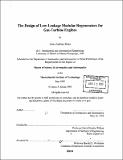| dc.contributor.advisor | David Gordon Wilson. | en_US |
| dc.contributor.author | Kluka, James Anthony | en_US |
| dc.date.accessioned | 2009-08-26T16:52:10Z | |
| dc.date.available | 2009-08-26T16:52:10Z | |
| dc.date.copyright | 1995 | en_US |
| dc.date.issued | 1995 | en_US |
| dc.identifier.uri | http://hdl.handle.net/1721.1/46564 | |
| dc.description | Thesis (S.M.)--Massachusetts Institute of Technology, Dept. of Aeronautics and Astronautics, 1995. | en_US |
| dc.description | Includes bibliographical references (p. [229]-231). | en_US |
| dc.description.abstract | The design of a modular regenerator concept (patented by Wilson and MIT) for gas-turbine engines is investigated. Mechanical design analysis and theoretical performance calculations were made to show the concept's functionality and performance benefits over current regenerator designs. The modular regenerator concept consists of a ceramic-honeycomb matrix discretized into rectangular blocks, called modules. The modules are exposed to hot (turbine exhaust) and cold (compressor outlet) streams, then are periodically transported through linear passages from one stream to the other. Separating the matrix into modules reduces the transverse sealing lengths substantially. Furthermore, the range of gas-turbine applications increases with the modular concept since larger matrix face areas are possible. Module design is investigated which includes using current research results pertaining to manufacturing technology for rotary regenerators. Mechanical design analysis was made to investigate the possible module-movement schemes. Several regenerator configurations and orientations are introduced. One particular concept balances the pressure forces such that the power requirement for module movement is reduced substantially. Design drawings of a possible modular prototype showing the general configuration and mechanical layout accompany the analysis. A method for determining the regenerator size and measuring its fluid-mechanical and heat-transfer performance is given. An optimization study is made by analyzing the effects when several chosen design parameters are varied. Numerical results of a modular concept for a small gas-turbine engine (120 kW) are given. Seal leakage calculations were made for two modular concepts and compared to the leakage rates for two rotary concepts. The total seal-leakage rates for both modular cases were considerably less than the rotary concepts and can be reduced to well under one percent. In addition, techniques for further leakage reduction are given. Other design issues (to further prove the modular concept's feasibility) not covered in this study have been identified. Guidelines for investigating these issues are given. | en_US |
| dc.description.statementofresponsibility | by James Anthony Kluka. | en_US |
| dc.format.extent | 234 p. | en_US |
| dc.language.iso | eng | en_US |
| dc.publisher | Massachusetts Institute of Technology | en_US |
| dc.rights | M.I.T. theses are protected by
copyright. They may be viewed from this source for any purpose, but
reproduction or distribution in any format is prohibited without written
permission. See provided URL for inquiries about permission. | en_US |
| dc.rights.uri | http://dspace.mit.edu/handle/1721.1/7582 | en_US |
| dc.subject | Aeronautics and Astronautics | en_US |
| dc.title | The design of low-leakage modular regenerators for gas-turbine engines | en_US |
| dc.type | Thesis | en_US |
| dc.description.degree | S.M. | en_US |
| dc.contributor.department | Massachusetts Institute of Technology. Department of Aeronautics and Astronautics | en_US |
| dc.identifier.oclc | 42242089 | en_US |
